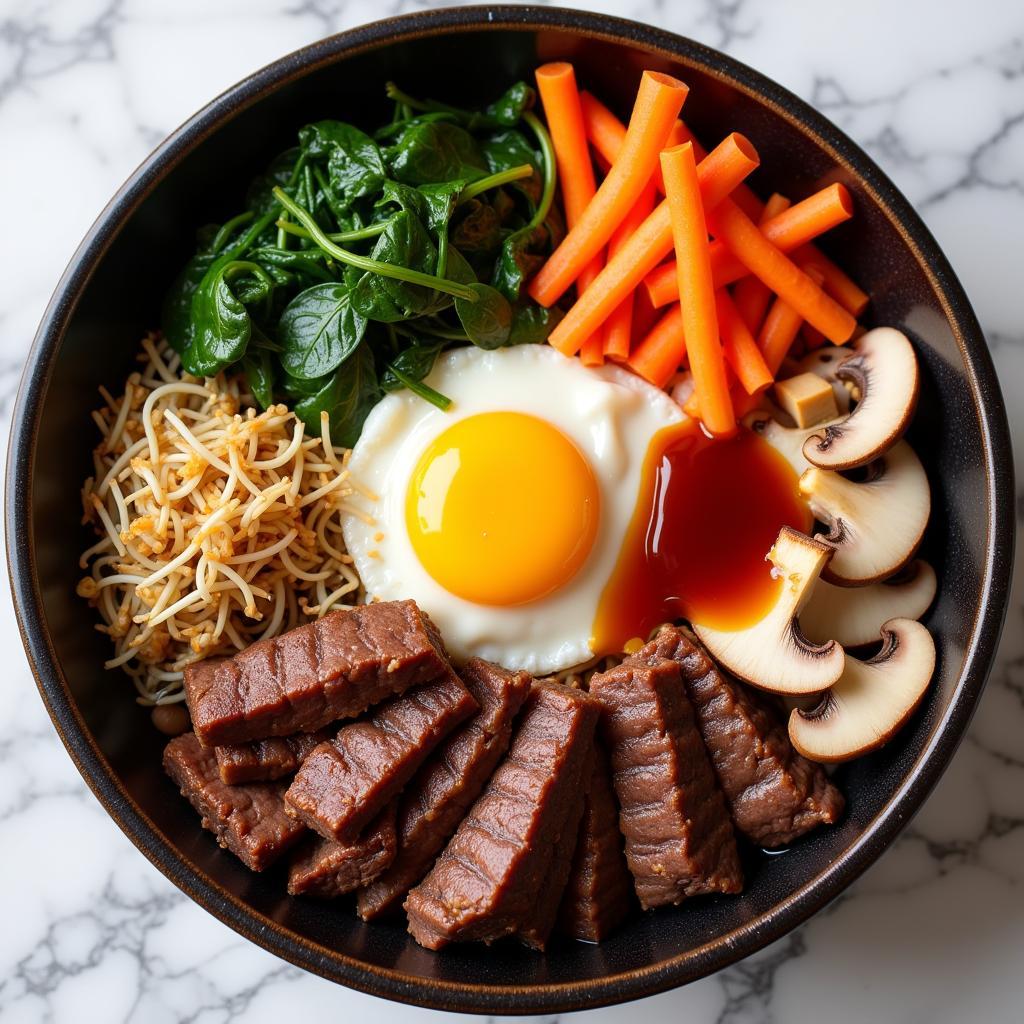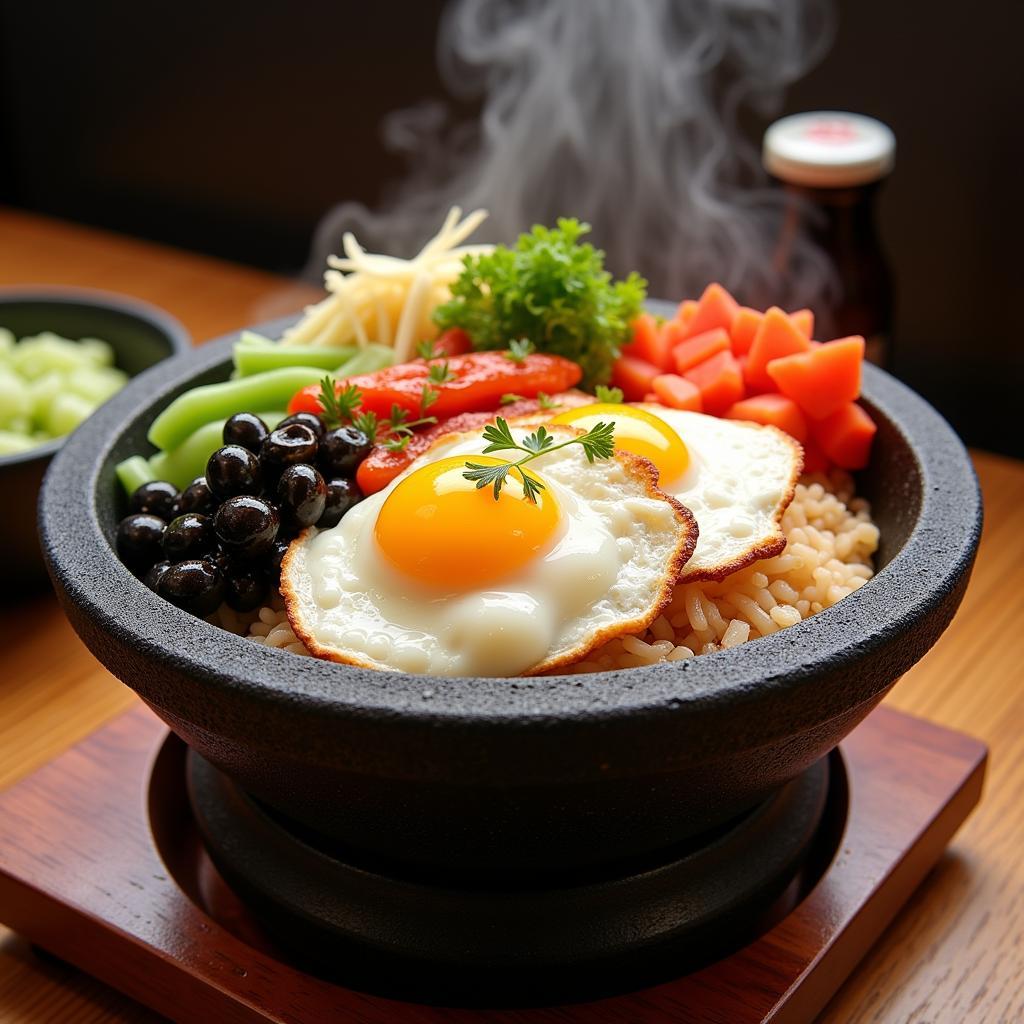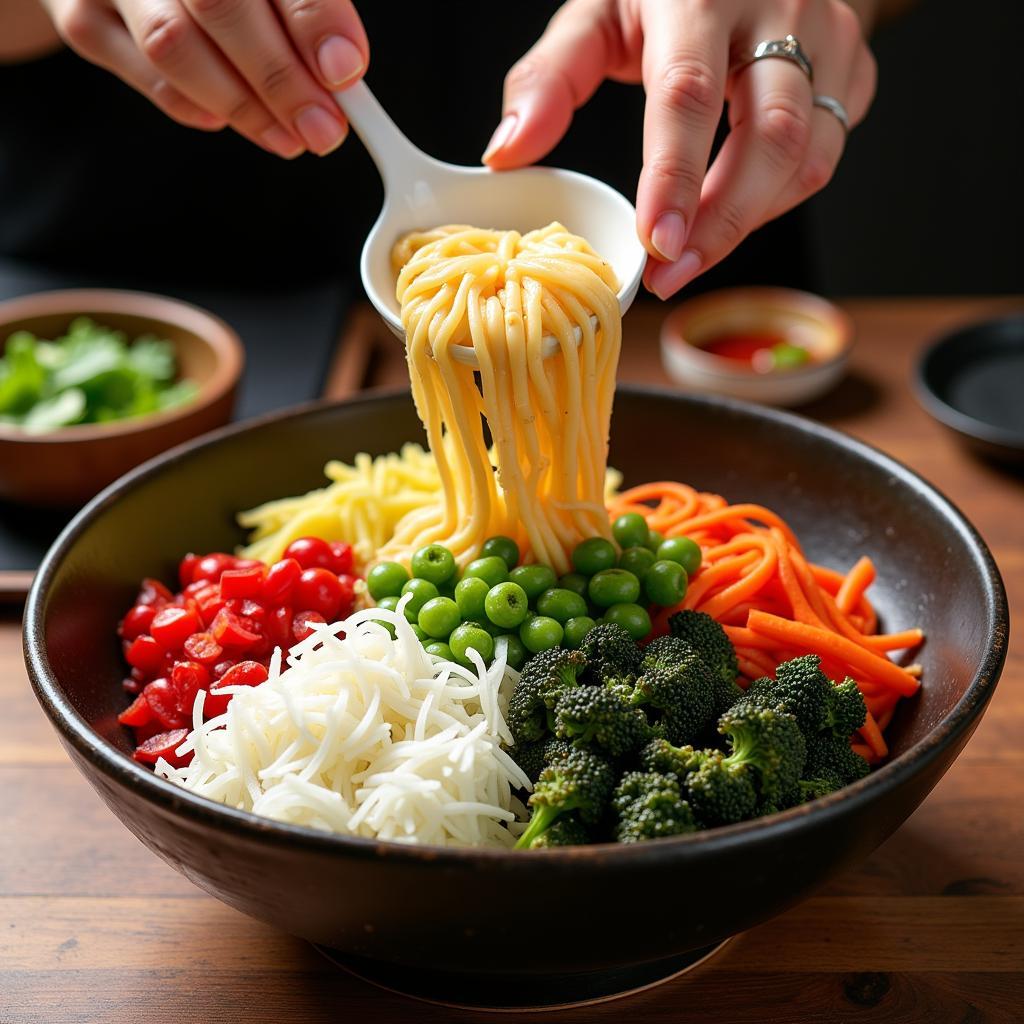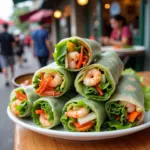Bibimbap, a vibrant and flavorful Korean mixed rice dish, is more than just a meal; it’s a culinary experience. This colorful bowl, packed with nutritious ingredients and a symphony of textures, has captured the hearts (and stomachs) of food lovers worldwide. But what exactly makes bibimbap so special? Let’s uncover the secrets behind this iconic Korean dish.
The Allure of Bibimbap: More Than Just Mixed Rice
Bibimbap, literally translating to “mixed rice with meat and assorted vegetables,” offers a delightful balance of flavors and textures. From the crispy rice at the bottom of the bowl to the array of seasoned vegetables, each bite is a journey for your taste buds.  Close-up shot of bibimbap ingredients: seasoned vegetables, marinated beef, fried egg, and gochujang sauce. But the true magic of bibimbap lies in its versatility. It’s a dish that can be tailored to individual preferences, dietary restrictions, and seasonal availability of ingredients. Whether you’re a vegetarian, a meat lover, or somewhere in between, there’s a bibimbap variation perfect for you.
Close-up shot of bibimbap ingredients: seasoned vegetables, marinated beef, fried egg, and gochujang sauce. But the true magic of bibimbap lies in its versatility. It’s a dish that can be tailored to individual preferences, dietary restrictions, and seasonal availability of ingredients. Whether you’re a vegetarian, a meat lover, or somewhere in between, there’s a bibimbap variation perfect for you.
A Rainbow of Flavors: Exploring Bibimbap Ingredients
The beauty of bibimbap lies in its diverse ingredients, each contributing a unique flavor and texture to the final masterpiece. Common vegetables include seasoned spinach, julienned carrots, vibrant bean sprouts, earthy mushrooms, and crisp cucumbers. Protein options range from marinated beef (bulgogi) and thinly sliced pork to chicken or tofu for vegetarian versions.  A sizzling hot stone bowl filled with bibimbap, topped with a fried egg and gochujang. A perfectly fried egg, often sunny-side up, crowns the colorful arrangement, while a generous dollop of gochujang, a fermented chili paste, adds a spicy kick.
A sizzling hot stone bowl filled with bibimbap, topped with a fried egg and gochujang. A perfectly fried egg, often sunny-side up, crowns the colorful arrangement, while a generous dollop of gochujang, a fermented chili paste, adds a spicy kick.
Bibimbap Variations: A Dish for Every Palate
From the traditional dolsot bibimbap served in a sizzling hot stone bowl to the more modern variations, there’s a bibimbap for everyone. Vegetarian bibimbap often features tofu or mushrooms as the primary protein source, while seafood bibimbap might include shrimp, squid, or other ocean delicacies. The flexibility of bibimbap allows for endless creativity, making it a favorite among home cooks and chefs alike.
What are some popular bibimbap variations?
Some popular variations include dolsot bibimbap (served in a hot stone bowl), Jeonju bibimbap (known for its raw beef), and vegetarian bibimbap (featuring tofu or mushrooms).
The Bibimbap Experience: Mixing it All Together
The real fun begins when you mix all the ingredients together, allowing the flavors to meld and the gochujang to coat every grain of rice. The contrast of textures – the crunchy vegetables, the tender meat, the runny egg yolk, and the crispy rice – creates a symphony in your mouth.  Close-up of a person mixing bibimbap with chopsticks in a stone bowl.
Close-up of a person mixing bibimbap with chopsticks in a stone bowl.
Beyond the Bowl: Bibimbap and Korean Culture
Bibimbap is more than just a dish; it’s a reflection of Korean culinary philosophy, emphasizing balance, harmony, and the use of fresh, seasonal ingredients. It’s a dish often shared with family and friends, further solidifying its place as a cultural icon.
Conclusion: Embark on a Bibimbap Adventure
From its vibrant colors and diverse ingredients to its unique blend of flavors and textures, bibimbap offers a culinary adventure that’s both satisfying and unforgettable. So, next time you’re craving a delicious and nutritious meal, try bibimbap – a true taste of Korea.
FAQ
What is bibimbap made of? Bibimbap typically consists of rice topped with sautéed and seasoned vegetables, meat (or tofu), a fried egg, and gochujang.
Is bibimbap spicy? The level of spice can be adjusted by adding more or less gochujang.
Where can I try authentic bibimbap? Korean restaurants worldwide offer bibimbap, but trying it in Korea offers a truly authentic experience.
Can I make bibimbap at home? Absolutely! Many recipes are readily available online.
Is bibimbap healthy? Yes, bibimbap is generally considered a healthy and balanced meal, packed with nutrients from various vegetables and protein sources.
What is dolsot bibimbap? Dolsot bibimbap is served in a sizzling hot stone bowl, creating a layer of crispy rice at the bottom.
What does bibimbap taste like? Bibimbap offers a complex blend of sweet, savory, spicy, and umami flavors, complemented by a variety of textures.
Do you have other questions about exploring Hanoi’s vibrant food scene? Check out our articles on “Must-Try Street Food in Hanoi” and “Exploring Hanoi’s Hidden Culinary Gems.”
Need help getting around Hanoi to try all the delicious food? Contact TRAVELCAR at: Phone: 0372960696, Email: TRAVELCAR[email protected], or visit us at 260 Cầu Giấy, Hà Nội. Our 24/7 customer support team is ready to assist you with car rentals (16, 29, and 45 seaters), airport transfers, and guided tours.

